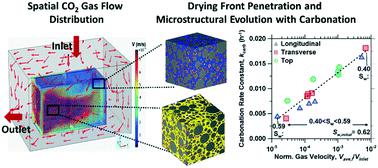当前位置:
X-MOL 学术
›
React. Chem. Eng.
›
论文详情
Our official English website, www.x-mol.net, welcomes your
feedback! (Note: you will need to create a separate account there.)
The role of gas flow distributions on CO2 mineralization within monolithic cemented composites: coupled CFD-factorial design approach
Reaction Chemistry & Engineering ( IF 3.4 ) Pub Date : 2021-1-11 , DOI: 10.1039/d0re00433b Iman Mehdipour 1, 2, 3, 4, 5 , Gabriel Falzone 1, 2, 3, 4, 5 , Dale Prentice 1, 2, 3, 4, 5 , Narayanan Neithalath 5, 6, 7, 8 , Dante Simonetti 3, 4, 5, 9, 10 , Gaurav Sant 1, 2, 3, 4, 5
Reaction Chemistry & Engineering ( IF 3.4 ) Pub Date : 2021-1-11 , DOI: 10.1039/d0re00433b Iman Mehdipour 1, 2, 3, 4, 5 , Gabriel Falzone 1, 2, 3, 4, 5 , Dale Prentice 1, 2, 3, 4, 5 , Narayanan Neithalath 5, 6, 7, 8 , Dante Simonetti 3, 4, 5, 9, 10 , Gaurav Sant 1, 2, 3, 4, 5
Affiliation

|
The carbonation kinetics of monolithic cementing composites are strongly affected by gas transport which is, in turn, influenced by microstructural resistances and the presence of liquid water within pore networks. The non-uniform gas flow distribution within the CO2 mineralization reactor can impart mass transfer resistance in the monolith microstructure, which affects the uptake of CO2 (“carbonation”) of the cementing composites. This paper demonstrates how the gas spatial distribution (velocity and flow rate; quantified by CFD analysis) and processing conditions (temperature, relative humidity, and flow rate; quantified by factorial design) affect drying and carbonation, and in turn, the engineering properties of a representative ‘monolithic’ carbonate-cemented concrete component (i.e., herein concrete masonry unit: CMUs, also known as concrete block). It is shown that the gas flow distribution affects drying front penetration and results in moisture and carbonation gradients within the monolith. Particularly, variations in drying kinetics caused by non-uniformity of the contacting gas velocity impose gradients in moisture saturation, which results in increasing microstructural resistance to CO2 transport. The resultant non-uniform carbonate-mineral formation (i.e., carbonate cementation), if not controlled, can produce gradients in mechanical properties and may alter failure patterns upon loading. These insights inform the optimal design of gas flow distribution systems and processing conditions within CO2 mineralization reactors for the manufacturing of low-CO2 concrete components using CO2-dilute industrial flue gas streams.
中文翻译:

整体水泥复合材料中气流分布对CO2矿化的作用:耦合CFD因子设计方法
整体胶结复合材料的碳化动力学受到气体传输的强烈影响,而气体传输又受到微结构阻力和孔隙网络内存在液态水的影响。CO 2矿化反应器内的气体分布不均匀会在整体结构中赋予传质阻力,这会影响固井复合材料对CO 2的吸收(“碳化”)。本文展示了气体的空间分布(速度和流速;通过CFD分析定量)和加工条件(温度,相对湿度和流速;通过析因设计定量)如何影响干燥和碳化,进而影响了气化炉的工程性能。代表性的“整体式”碳酸盐水泥混凝土构件(也就是说,这里是混凝土砌体单位:CMU,也称为混凝土砌块。结果表明,气流分布影响干燥前沿的渗透,并导致整料内部的水分和碳化梯度。特别地,由接触气体速度的不均匀性引起的干燥动力学的变化强加了水分饱和度的梯度,这导致对CO 2输送的微结构阻力增加。如果不加以控制,所得的不均匀的碳酸盐-矿物地层(即碳酸盐胶结)可能会产生机械性能梯度,并可能在加载时改变破坏模式。这些见解为CO 2内的气流分配系统和处理条件的优化设计提供了依据矿化反应器,用于使用稀释了CO 2的工业烟气流制造低CO 2混凝土组件。
更新日期:2021-01-15
中文翻译:

整体水泥复合材料中气流分布对CO2矿化的作用:耦合CFD因子设计方法
整体胶结复合材料的碳化动力学受到气体传输的强烈影响,而气体传输又受到微结构阻力和孔隙网络内存在液态水的影响。CO 2矿化反应器内的气体分布不均匀会在整体结构中赋予传质阻力,这会影响固井复合材料对CO 2的吸收(“碳化”)。本文展示了气体的空间分布(速度和流速;通过CFD分析定量)和加工条件(温度,相对湿度和流速;通过析因设计定量)如何影响干燥和碳化,进而影响了气化炉的工程性能。代表性的“整体式”碳酸盐水泥混凝土构件(也就是说,这里是混凝土砌体单位:CMU,也称为混凝土砌块。结果表明,气流分布影响干燥前沿的渗透,并导致整料内部的水分和碳化梯度。特别地,由接触气体速度的不均匀性引起的干燥动力学的变化强加了水分饱和度的梯度,这导致对CO 2输送的微结构阻力增加。如果不加以控制,所得的不均匀的碳酸盐-矿物地层(即碳酸盐胶结)可能会产生机械性能梯度,并可能在加载时改变破坏模式。这些见解为CO 2内的气流分配系统和处理条件的优化设计提供了依据矿化反应器,用于使用稀释了CO 2的工业烟气流制造低CO 2混凝土组件。











































 京公网安备 11010802027423号
京公网安备 11010802027423号